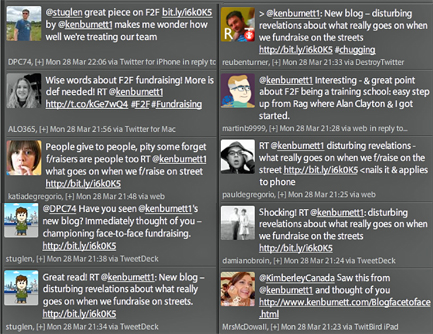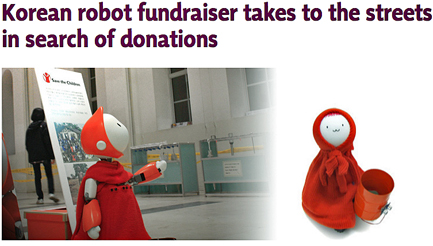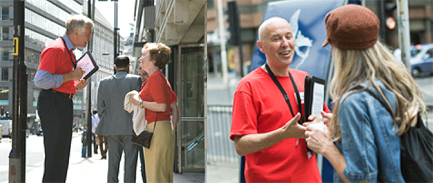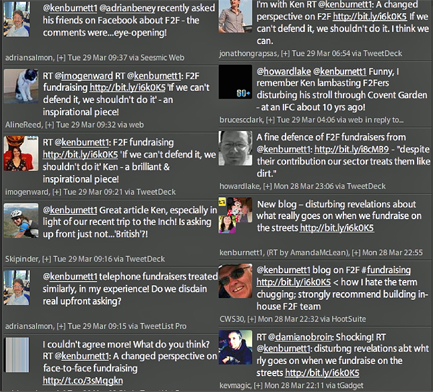I’ve had more correspondence about my article on this issue than on any other for a long time. Clearly, street fundraisers care about how the public views them and are prepared to stand up and defend what they do. Reassuringly, other fundraisers too are sticking up for F2F. And most also agree it could be done a lot better. See one innovative idea, opposite. And a couple of new reactions, below.
From Andy Delve, Bristol, UK.
‘I absolutely love this article about street fundraising. I got a job as a street fundraiser to pay the rent whilst looking for a “proper job”. I loved it so much and found it so personally rewarding that I have never looked back and am now in my tenth year. I currently work as a consultant setting up in-house street fundraising campaigns within an organisation’s existing fundraising department. I can totally relate to your experiences and it is great to know that you will be ‘off the fence’ and fighting our corner from now on.’
Andy Delve, Inspired People, Bristol, UK.

From Nicola Garrard, Australia
‘I just read your blog and it is so refreshing and inspiring! I have been in the f2f world for 7 years now, starting on the street, working my way through the supplier ranks, and now managing the program from the client side – hopefully injecting some enthusiasm for the channel into my colleagues!
I have always trained fundraisers to be proud of what they do – when they get the inevitable ‘oh, you’re one of those people’, to stand up straight and reply ‘absolutely! Every day I go out, work hard and go home knowing that I've contributed to the world in a positive way’.
So thank you for reminding you why I'm still here after all these years, and I will most definitely be passing your piece to my colleagues.
Nicola Garrard, Marketing – Direct Acquisition, Plan Australia National Office.
From Penelope Blackwell, Edinburgh, Scotland.
We don’t use it here because I know I could never sell it to my boss, but I know it works because both my boys have done it – one through an agency and one with an Irish charity that does its own F2F. Their stories of how people treated them on the streets were appalling and they both eventually gave up, though they were good at it. My younger one had some pretty dire stories about how they were treated by the agency, and by the client – especially penny-pinching on the training.
Penelope Blackwell, CHSA Scotland
From Jim Thalhuber, St Paul, Minnesota.
Wow! You really got whipped up about this one! Sorry, but I can’t share your passion. It’s not that I don’t agree with your premise; it’s just that, quite honestly, I’ve never been involved in a F2F campaign, never been approached by a street fundraiser, never even heard any of my colleagues talk about F2F (I had to read your post to find out what it actually is). Have I been living under a rock?
Once again, your words have put me to thinking. Could this be an element of our fundraising mix? Is this a viable strategy to reach an audience that we may never be able to reach with our conventional, comfortable approaches? Is this an opportunity to cut through the clutter with something unique in this market? We’re looking for stuff that works.
The key for me would be, if we would do it, it would be worth doing well. Invest in training, process, procedure, testing, etc. My mantra is “Never do anything that wouldn’t make dear old Mom proud of me.” Same for F2F.
Can’t wait to see what more of your confreres think.
Jim Thalhuber Vice President of Development and Marketing
Goodwill/Easter Seals Minnesota.
From Ian McQuillan, London
I’ve just read your blog about F2F. It’s not an overstatement to say that a lot of people in F2F are thrilled by such insightful support for what they do. As head of comms here, I rarely get the chance to discuss F2F at this level of sophistication because most of the journalists who contact us just don’t want to know about it and, with our dual role of regulator and advocate, we have to tread a fine line in the kind of messages we put out: any too forthright defence sounds like a case of special pleading. So for someone with your reputation to have written something like this carries orders of magnitude more weight than anything we could have said.
Ian MacQuillin, Head of Communications, Public Fundraising Regulatory Association.
From Giles Pegram, London
Ken, I agree with every word you say, and I think it needs to be said more often by more people. There are four points I’d add.
First, F2F fundraisers are no more intrusive than the formidable ladies who were to be found on our High Streets in the sixties and seventies with their tray of flags. Woe betide you if you weren’t wearing one by the time you got home.
Second, the average gift of a donor recruited this way is higher than any other means, by quite a margin. After initial attrition, they are loyal and have a high lifetime value. These collectors are introducing a new demographic to the joy of philanthropy, young people who are going to get wealthier as they grow older and, having discovered philanthropy, are going to give more of their money away. This is just the start.
Third, while in dialogue with the prospect, they are the embodiment of the cause and all its values. Yet we pay far less attention to what they say about us than we do to any DM pack.
Finally, even within charities, F2F people are known as ‘ chuggers’. This is dreadful.
Giles Pegram CBE, former director of appeals at NSPCC, now a consultant.
April 2011
From Calli Pelligrini, London,
Ah Ken, if you’d only been with me one sunny Saturday afternoon in London’s West End where the third F2F fundraiser I’d encountered was body-blocking me like a professional American basketball player. He thought he was being charming. My interpretation was somewhat different.
Despite the sterling work of the cohort as a whole there are enough bad apples out there to have a fairly toxic effect on the bushel. I’ve never worked with F2F so I don’t know how they’re recruited and trained. But until their induction includes some rigorous training on the difference between influencing and pestering, the debate will continue.
Calli Pellegrini, head of high value partnerships at Leonard Cheshire Disability, London.
From Michael Fogarty, Melbourne
Ken, thank you for raising such an important issue for the industry.
One advantage of being an antipodean far away from the bright lights of innovation in the northern hemisphere is that we’ve been able to learn from the stresses faced by the industry there. So as the pressure developed from the media and regulators in the UK, the industry here worked towards a coordinated response to media, competition for locations and local council regulation.
This coordinated response has helped to contain - but of course not eliminate – negative responses to F2F including public angst. And I believe that it may also have had an effect on fundraisers’ own attitudes. There are of course boards and senior managers of charities like those that Penelope Blackwell has to deal with, however I find that there are almost universally positive attitudes towards F2F and our representatives on the street, by those who have it as one of their fundraising tools.
When I read your first article, I immediately passed it on to our F2F agency, Public Outreach, and asked them to `please pass it on to all of our representatives on the street and tell them how much we appreciate their fabulous efforts!’. I meant it and I’ll ensure that they have your recent article and again remind them of our high regard for their fine work.
My advice to F2F fundraisers who still feel undervalued and under appreciated is to consider a working holiday down under: the weather’s great, your accent will be an advantage on the street and clients like Bush Heritage will welcome you with open arms.
Michael Fogarty, Chief Marketing Officer, Bush Heritage Australia.
May 2011
 Comment
Comment









